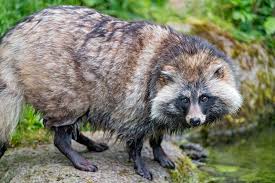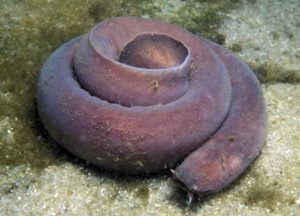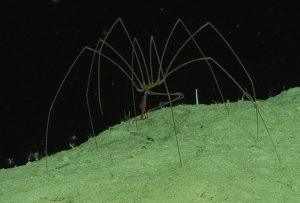Podcast: Play in new window | Download (Duration: 22:33 — 22.9MB)
Thanks to Nicholas for suggesting this week’s episode topic! Lots of strange and fascinating insects and other animals are found trapped in amber. So what is amber, how does it preserve animal parts, and most importantly, what have scientists found in amber?
A millipede preserved in amber, one of 450 millipedes discovered in Myanmar amber. Somebody had to count them:
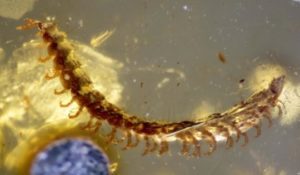
A newly described insect that got its own order because it’s so weird. Look at that triangular head with giant eyeballs!
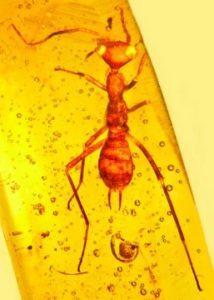
A mushroom, a hair, and a tiny phasmid exoskeleton, all caught in amber:
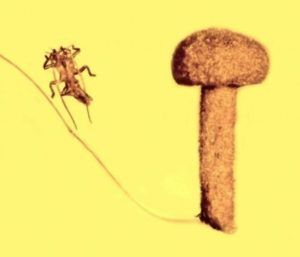
Show transcript:
Welcome to Strange Animals Podcast. I’m your host, Kate Shaw.
Last month I released an episode about trace fossils, and listener Nicholas wrote me to suggest I also do an episode about amber—specifically, the animals and other items that were trapped in amber and preserved inside it when the amber fossilized. Nicholas also sent me lots of links to really interesting articles!
Amber is the term for fossilized tree resin. If you’ve ever climbed a pine tree and ended up with pine sap all over your hands, which is impossible to get off by just washing your hands and is super sticky and picks up every bit of dirt, you’ll have an idea of what amber starts out as and why it sometimes has insects and other stuff in it. Despite the name pine sap, it’s not actually sap. Sap is the fluid that carries nutrients around to a plant’s cells, sort of like plant blood. Resin is secreted by certain trees and other plants for various reasons, including to protect it from insect damage, to kill fungus, to seal off a broken branch or other injury, and to taste bad so herbivores won’t eat it.
There are different types of amber, because there are different plants that produce resin. We don’t always know what species of plant a particular type of amber comes from, since many are now extinct and can’t be directly studied. Conifer trees evolved around 300 million years ago but became really successful during the Mesozoic around 250 million years ago, spreading throughout the world and dripping resin all over the place. Conifers include pine trees, fir trees, hemlocks, yews, larches, junipers, cedars, redwoods, spruces, and lots of other trees and shrubs that are still widespread today. Some flowering plants, mostly trees, also produce resins. But before conifers evolved and outcompeted them, plants called medullosales lived around the world and produced resin too. Medullosales first appear in the fossil record around 360 million years ago and mostly died out around 298 million years ago. They’re all extinct now.
If your name is Amber, by the way, you are named for fossilized tree resin. That sounds gross, but amber has been prized for millennia as a gemstone. When polished, it can be a gorgeous yellow, gold, or brown, often the color of honey. But some amber is other colors, including red, blue, or green. It all depends on what tree originally produced the resin, its chemical makeup, and how it was fossilized.
So how does the resin fossilize? Sometimes it would drip onto the ground, become buried, and fossilize along with the ground around it. Sometimes the resin-producing tree would fall, become buried, and the resin inside would fossilize along with the wood. Sometimes the resin would drip into water, float to a quiet area or sink to the bottom of the pool or lagoon, and fossilize along with the sand and other sediment that covered it. This is why so much amber is found in the ocean, by the way. Once fossilized, amber floats in salt water—just barely, but enough that on some beaches it’s commonly washed up with the tide. People collect the pieces of amber to polish and sell. Amber can also be burned and often gives off a musky, piney scent that has been used in religious ceremonies.
The reason we’re talking about fossilized plant material in an animal podcast is that amber sometimes has insects or other small animals or animal parts inside it. This happened when it was still resin, which is really sticky. If an ant or bee was in the wrong place at the wrong time, it could be covered with resin and die. Then, if that particular dollop of resin ended up getting protected by sediment at just the right time, instead of weathering away and decaying it might fossilize over millions of years with the ant or bee or whatever inside it. And because the ant or bee was protected from air, water, and bacteria by the resin, and kept in place, the things found in amber are usually mostly intact and include parts of the body that ordinarily never fossilize. It may even help preserve DNA, which ordinarily decays after a matter of thousands of years, although there’s still conflicting evidence about whether this is the case. All this helps researchers study animals that went extinct millions of years ago almost as though those animals were still around.
Substances inside amber are called inclusions, whether they’re something exciting like a spider or just a piece of dirt. Well preserved inclusions, especially pretty ones like flowers, can make the piece of amber extremely valuable. If you want to buy polished amber with an inclusion, though, keep in mind that there are a lot of fakes out there. Make sure to have an expert examine an expensive piece before you spend money on it.
So let’s learn about some insects and other things that have been discovered in amber. I’m going to mention Myanmar repeatedly because it’s a big amber-producing region and the subject of an intensive ongoing study of animals found in the amber. Myanmar is in southeast Asia and was once called Burma.
The oldest organism found in amber are two tiny mites and a fly dated to 230 million years ago. The amber in question is very small, droplets no more than about six millimeters across, found in the Italian Alps. The mites are two different species, both new to science although they have living relations that resemble the ancient mites closely. Both of them ate plants. The fly isn’t as well preserved so researchers aren’t sure what species it was.
A 3 millimeter beetle found in amber dated to 99 million years ago was found in Myanmar. It’s an ancient relative of the modern flat rove beetle that lives under tree bark. But the flat rove beetle lives in South America, with one species from southwestern North America. Comparing the modern beetles with their ancestor gives researchers a closer idea of when the supercontinent Gondwana started to split apart into smaller continents as the landmasses moved slowly across the Earth to their current positions.
The amber found in Myanmar has yielded a lot of interesting information during recent studies. For instance, 450 millipedes! Not all in one piece, of course. The research team used a new type of analysis called micro-CT, which scans the inclusion and creates a highly detailed 3D image which can then be studied without damaging or even touching the amber. This is helpful when the amber pieces are privately owned and only on loan to scientists. Some of the millipede specimens were newly hatched, some fully grown, and include many species new to science.
Another insect found in Myanmar amber dated to 99 million years ago is so unusual that researchers placed it in its own order. To illustrate how rare this is, there are over a million insects described by scientists but they all fit into 31 orders. But now there’s 32 orders. The insect had a triangular head with big bulging eyes, a long flat body, long legs, and no wings. It also had glands on its neck that secreted chemicals that probably helped repel predators. Because of its large eyes and the unusual head shape, it could see almost all the way around it without turning its head. Two specimens of the extinct insect have been found in amber. One of the researchers who described the insect, amber expert and entomologist George Poinar, Jr, said that he thought it looked like an alien’s head so he made a Halloween mask that looked like it. As you do. He said “when I wore the mask when trick-or-treaters came by, it scared the little kids so much I took it off.”
It’s not just insects that are found preserved in amber. One foot and part of a tail from a 100 million year old gecko were found in amber about a dozen years ago. Researchers think the rest of the gecko was probably eaten, possibly by a dinosaur. Even though there isn’t a lot of the gecko to study, there’s enough to determine that it was a genus and species new to science, and that it was probably a juvenile gecko that would have grown up to a foot long if it had lived, or 30 cm. It was only about an inch long when it died, or a bit over two cm. It was stripey and had the same type of toe pads that modern geckos have that allow them to walk up walls.
Another foot, this one from a frog, was discovered in more of the Myanmar amber that’s the subject of ongoing studies. It was a tiny juvenile frog that lived in a tropical forest around 100 million years ago. It’s only the third frog ever found in amber, and is by far the oldest in addition to being the best preserved. Its skull, forelegs, part of its backbone, and the partial hind leg and foot are all preserved, together with a beetle. The problem is, some of the details researchers need to determine what kind of frog it is are missing, like the pelvis. They have just enough information to tantalize them since what they can see indicates that it might be related to some species of toad that live in temperate climates today, but not enough to tell for sure. You know they have to be tearing their hair out in frustration. Hopefully they’ll find another frog with all the bits and pieces they need.
Another surprise from the Myanmar amber is a baby snake only about two inches long, or 5 cm. At first researchers thought it was yet another millipede—I mean, when you’ve found 450 millipedes in amber you probably start to think everything is a millipede—but a scan determined that it was way different. It’s well preserved and even shows some features that modern snakes no longer have, like V-shaped bone spurs on the tail vertebrae that probably helped with stability when snakes first evolved to be limbless. Unfortunately the specimen is missing its skull.
Only one salamander has been found in amber, and it came from a surprising place. The amber was mined from the mountains of the Dominican Republic, which is in the Caribbean near Haiti. But there are no salamanders in the Caribbean today. The salamander in amber dates to around 25 million years ago and proves that salamanders did once live in the Caribbean. Not only that, the amber itself comes from an extinct tree that’s related to a tree native to East Africa. The salamander was a tiny juvenile that fell into a glob of resin after a predator bit one of its legs off. So, you know, it was doomed either way. Poor little salamander.
One really exciting discovery is part of an actual dinosaur tail trapped in amber. It came from a juvenile dinosaur that a scientist found at a market in Myanmar in 2015. The seller thought the tail was a plant, because—you’ll like this—it’s covered in FEATHERS that looked like bits of leaf. It’s dated to 99 million years ago. The feathers were chestnut brown on the tail’s upper surface and white underneath. They’re also very different from modern bird feathers. Researchers aren’t sure which dinosaur species the tail is from, but they do note that the dinosaur died, probably because it couldn’t get free from the resin. It wasn’t like some modern lizards that can drop their tails to escape predators.
Lida Xing, the same researcher who acquired the dinosaur tail in amber also managed to buy a bird in amber in the same Myanmar amber market. Only a few birds have been found in amber and they sell for ridiculous amounts of money—like half a million dollars—to private collectors. As a result, they’re rarely studied. Fortunately, Lida Xing was able to buy the bird in amber and it’s been studied ever since. It’s a young bird that was partially weathered away and squished after it died. It’s about 2 ½ inches long, or 6 cm, and is a type of primitive bird that went extinct at the same time as the non-avian dinosaurs 66 million years ago. It was dark brown and had teeth and clawed fingers on its wings, although both the beak and the finger-wings are missing from the specimen.
Sometimes marine or freshwater organisms are found in amber. For a long time no one understood how this happened, but in 2007 a team of researchers conducted a simple study to find out how it worked. One of the researchers owned some swampy property in central Florida. The team went there and cut pieces out of some pine trees growing in the swamp. Resin flowed from the trees’ injuries, down the trunk, and into the water. The researchers then collected the resin from the water and took it to a lab to examine it. They found water beetles, nematodes, small freshwater crustaceans, mites, even bacteria found in swampy water, all stuck in the blobs of resin. In other words, it’s not a bit unusual for water animals to get caught in resin. The unusual part is when they’re preserved in the resin long enough for the resin to fossilize into amber, and then the really rare part is when they’re found by a human who understands what they’re looking at and realizes it’s important.
Some of the most useful information preserved in amber concerns animal behavior. For instance, the recent discovery of a tick wrapped in spider silk. Spiders don’t usually eat ticks, but occasionally they do, and this tick in amber had been wrapped up in spider silk to immobilize it. Researchers aren’t sure whether the spider planned to eat the tick or was just stopping it from tearing up its web. Either way, it fell out of the web and plopped right into resin, which fossilized and was then found around 100 million years later. From this little piece of amber, we have direct evidence of a spider wrapping up its prey the same way they do today.
Another example is dated to 130 million years ago, when some green lacewing eggs hatched and the larvae and eggs were trapped in resin almost immediately. The green lacewing is a type of flying insect that’s still around today, although the ones found in resin are a species new to science. Since the babies were covered in resin during the act of hatching, researchers have learned a lot about how they emerged from the eggs.
There’s even a piece of amber dated to around 100 million years ago, also found in Myanmar, that shows a dragonfly with a missing head, together with the foot and tail of a tiny lizard. Researchers think the lizard may have caught the dragonfly and decapitated it to kill it, but before it could eat it, both predator and prey were trapped in resin. It’s too bad we don’t have the lizard’s head, because it would be really awesome if it had the dragonfly’s head in its mouth.
Some pieces of amber tell a story like this, like a photograph from millions of years ago. About 50 million years ago near what is now the Baltic Sea, a small mammal, possibly a rodent, bit a mushroom off at its base. A tiny insect, specifically a phasmid, or walking stick, was feeding on the mushroom and jumped away. All this happened just as a blob of resin dropped on the scene. The mammal fled, leaving behind a hair. The insect was trapped but was able to wriggle out of its exoskeleton in an early molt and escape, leaving its exoskeleton behind. The mushroom did nothing, because it was a mushroom. That particular phasmid species is now extinct, as is the mushroom species. Researchers don’t know much about the mammal. They know that the exoskeleton was literally shed moments before it was enveloped in resin because it still shows tiny filaments that would have crumbled away otherwise.
Even more dramatically, another piece of amber, again from Myanmar and about 100 million years old, shows a spider in the act of attacking a wasp. Both the spider, a bristly orb-weaver, and the parasitic wasp are still around today.
Other things are also preserved in amber, from pollen and plant spores to feathers and spiderwebs. It’s mined and gathered in various parts of the world for jewelry, so new amazing specimens could be discovered any day.
I could literally just keep going with this episode for hours talking about what’s been found so far, but I have to stop somewhere so I’ll leave you with one last amber inclusion.
It’s another strange insect new to science, also found in Myanmar amber dated to about 100 million years ago. It was tiny but really weird-looking. Researchers have been referring to it as a unicorn fly because it had a sort of horn sticking up from the top of its head that had three eyes at its tip. Researchers think its specialized horn with eyes on it gave it an advantage when flowers were tiny, as they were back in the early Cretaceous when it lived. Flowering plants had only recently emerged and were diversifying rapidly. It probably ate pollen and nectar. But when flowers evolved to be larger, it lost its evolutionary advantage and went extinct. It also had tiny mandibles that meant it could only eat very small particles of food, long legs, and weirdly shaped antennae.
The unicorn fly was described by our friend George Poinar, who described the weird insect with the triangular head too. And true to form, Dr. Poinar is up to his same tricks. He’s reported as saying that he was “thinking of making some masks based on it for Halloween.”
George, no! The children are frightened! Stop making Halloween masks!
One note about listener suggestions. I’ve been getting a lot of them lately, which is awesome, but I don’t necessarily use the suggestions in order. Which one I pick out for the next episode depends on a lot of things, including how much time I have for research, what strikes me as neat on any given day, and whether I can work a suggestion in to a planned episode about a larger topic. But I promise I do keep all suggestions in a list, and I will eventually get to them all! I’m always delighted to get more, too, so don’t feel like I’m telling you not to send any. Some of the best episodes I’ve done have been from listener suggestions, about animals I’d never heard of before.
You can find Strange Animals Podcast online at strangeanimalspodcast.com. We’re on Twitter at strangebeasties and have a facebook page at facebook.com/strangeanimalspodcast. If you have questions, comments, or suggestions for future episodes, email us at strangeanimalspodcast@gmail.com. We also have a Patreon if you’d like to support us that way.
Thanks for listening!






